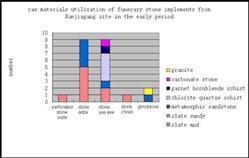
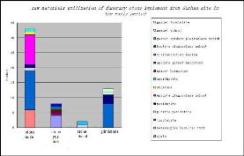
Graph 1: Raw material utilisation of funerary stone implements from the site of Xuejiagang in the early period
Graph 2: Raw material utilisation of funerary stone implements from the site of Gushan in the early period
Metamorphic, igneous rocks were the major sources used during the period of the Xuejiagang culture. Artefacts made from sedimentary rocks do occur, but are a small percentage of the whole. The metamorphic rocks include slate, schist, altered sandstone and phyllite; the igneous rocks include peridotite, troctolite, dunite, rhyolite and granite. The sedimentary rocks include siltstone, sandstone and shale. For the research reported here, 12 samples from three different sites were selected for preparation as thin-sections, which were then characterised under a polarizing microscope by Wei Chunjing. These were then compared with lithologies reported in earlier reports from, for example, Gushan and Xuejiagang. All the thin-sections are from metamorphic rocks; slate, hornstone, phyllite and mudstone.


Graph 1: Raw material utilisation of funerary stone implements from the site of Xuejiagang in the early period
Graph 2: Raw material utilisation of funerary stone implements from the site of Gushan in the early period
The characteristics of raw materials utilisation show some interesting trends (see Graphs 1 and 2). In the early period at Xuejiagang, slate accounted for 48%, while metamorphic sandstone comprised a further 24% of all characterised artefacts. The remainder was composed of chlorite schist and granite (ICHRA 2005). There are also correlations with implement morphology. For example, all of the perforated stone knives recovered from Xuejiagang were of slate. By contrast, the raw materials for Yue axes were more variable, comprising slate, schist and hornstone. The greatest variability is found among the raw materials used for adzes and a few chisels; slate and metamorphic sandstone were used at Xuejiagang, metamorphic basaltic tuff, garnet schist, and (most commonly) troctolite were used at Gushan. Interestingly, the grindstones unearthed from the Gushan graveyard were made of the same materials as the adzes and chisels found on site. Rather different materials appear to have been used to make the smaller number of grindstones recovered from the cemetery at Xuejiagang.
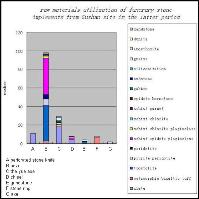
Graph 3: Raw material utilisation of funerary stone implements from the site of Gushan in the later period
In the later period, where our evidence comes from cemeteries and from settlements, the latter including Wangyangmiao, Fuzicheng and Wangjiadun, a number of changes can be observed. For example, the frequency of perforated stone knives appears to increase, as does that of Yue axes. Most of these perforated knives were made of slate, but a few of metamorphic sandstone and gabbro were also identified. Among the Yue axes, slate accounted for 61%, while metamorphic sandstone took 25% at Xuejiagang, with chlorite quartz schist, garnet schist, gneiss and granite making up the remainder. At Gushan, while the kinds of raw materials used remained largely unchanged from the earlier period, relative proportions look rather different (Graph 3). Although troctolite remains common, slate and epidote plagioclase schist show increased frequencies. Metamorphic basaltic tuff and picrite peridotite are also more common. Moreover, 62% of Yue axes on site are made of slate, with lower frequencies of sandstone and metamorphic basaltic tuff used for these forms. For the most part, the adzes from Gushan maintained the characteristics of the early period. At Xuejiagang, 60% were made of slate, 30% of metamorphic sandstone and 10% of rhyolite hornstone (Graphs 4 and 5).
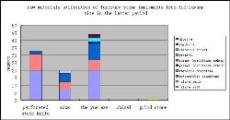
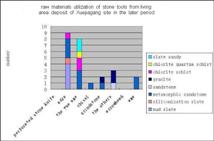
Graph 4: Raw material utilisation of funerary stone implements from the site of Xuejiagang in the later period
Graph 5: Raw material utilisation of stone tools from living area deposit of the site of Xuejiagang in the later period
These patterns can be compared to those seen elsewhere. Slate Yue axes, perforated knives, and metamorphic sandstone adzes were discovered in the cemetery at Huanglong (Huaining county). Slate Yue axes were also found in tombs at Fuzicheng, Anqing city. At Chishan, a variety of stone implements were also unearthed, and out of 51 studied for this article, 14 were made of slate. Slate was also used for Yue axes and perforated knives at Guayushan. However, like Chishan, not all information relating to the site has yet been published, making inferences partial at best. The area around Huangmei has also revealed evidence for three important Xuejiagang culture sites. Only one of these, the Ludun cemetery, has been published and, here again, slate and metamorphic basaltic tuff were used for Yue axes (IACASS 1991). Adzes made of troctolite, sandstone, peridotite, and epidote plagioclase schist were also unearthed at Zhengjiaao, Jingan city. Here, however, slate was not represented, an absence probably related to the lack of Yue axes and perforated knives in the assemblage. Slate perforated knives and Yue axes, phyllite Yue axes, and troctolite, epidote plagioclase schist adzes were also unearthed at Dawangling, Jiujiang City. In addition, slate Yue axes were found during survey work at Qingyunpu, Nanchang City.
Stone tools from occupation deposits also showed some interesting patterns. At the edge of Xuejiagang cemetery, deposits contemporary with the tombs of the later period contained assemblages of stone implements similar to those found in secure funerary contexts (ICHRA 2005). Stone axes, adzes and grindstones unearthed from the remains of a domestic structure were made of slate, granite and gneiss. Yue axes of phyllite and breccia were also unearthed from pits at Fuzicheng, while slate arrowheads were recovered from pits and layers at Wangyangmiao. The raw materials used here included chlorite schist, garnet, hornstone, troctolite, peridotite, and metamorphic basaltic tuff. Several pieces of Yue axe were unearthed at Wangyangmiao, all showing signs of reworking.
Patterns can also be identified in survey data. Collections from Neolithic sites in Wangjiang demonstrate that slate, metamorphic sandstone and limestone were all used for making Yue axes. Troctolite, epidote plagioclase schist and mica hornblende schist adzes can also be found. Along with artefacts of other materials, there are slate Yue axes and perforated stone knives in collections from Daizui and Yerenwan, Susong county, and in the counties of Taihu and Yuexi (at Guxingtu and Wuhe) to the west. Adzes of metamorphic sandstone, slate and peridotite, and other products made from gabbro, sandstone, quartzite and carnelian, were also collected at Yerenwan county, together with sericite schist stone rings.
The main trends to be identified from these data are as follows. Over the course of time (early to later phase), Xuejiagang stone implement assemblages show an increasing concern with raw material selection. In the early period, the use of raw materials to make particular kinds of tools tends to vary between sites. In the later phase, perforated knives and Yue axes become more common, and the majority of these show a consistent preference for slate and metamorphic sandstone, particularly in funerary assemblages. Indeed, demand for items to be used in these settings may well have increased over time.
Raw materials selection was also linked relatively closely to the intended form and use of tools. Things certainly varied, but generally, the properties of different stones influenced choice and patterns of working. Slate and phyllite are both easily split into flat flakes and thus are suitable for making stone knives and Yue axes. By contrast, the igneous rocks and metamorphic sandstones or tuffs are harder and more suitable for making adzes and chisels. What is also clear is that the raw materials used for tools found on settlements, or those which appear to have played a largely practical role, are more varied than those represented in funerary contexts.
There are also more basic patterns that hint at other processes at work, including the longer distance transport of particular materials. The frequency of slate across sites is quite varied, and there is evidence to suggest that items made from this material were often recycled or highly curated on settlements. In these settings, slate arrowheads are often smaller than those in funerary settings, and most Yue axes and perforated knives are either broken or show signs of reworking.
© Internet Archaeology/Author(s) URL: http://intarch.ac.uk/journal/issue26/33/3.html
Last updated: Wed Jul 29 2009